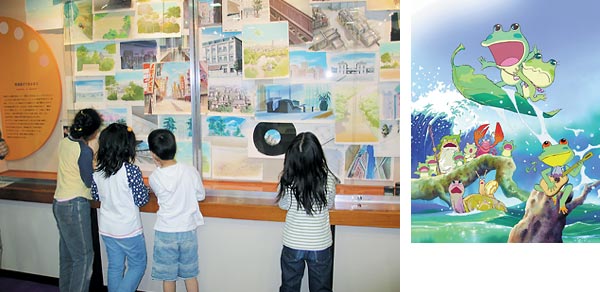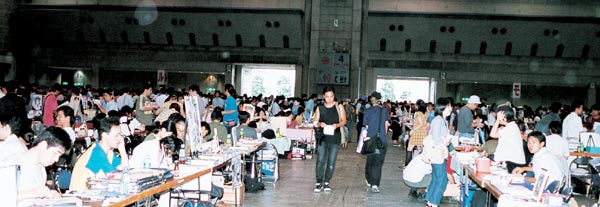|
|
|
NIPPONIA No.27 December 15, 2003
|
|
Special Feature*
The Production Center for Animé
Suginami Ward, Tokyo

Japan's animé industry is said to be worth 5 trillion yen. Of the approximately 440 animé production companies in Japan, about 80% are situated in Tokyo. Many began in Suginami Ward, which is located in west-central Tokyo. More than half of Japan's animé companies are located there or in the neighboring municipality, Nerima Ward.
In 2000, the Suginami municipal government launched an initiative in recognition of the fact that animé production represents an important local industry. To promote the industry further, it worked with animé companies to develop the "Animé Paradise Project for Suginami." Programs include an annual animation festival organized by the local government and animé companies, and trips to production centers for children attending elementary and junior high schools in the city. Other programs also give local residents a chance to become more acquainted with the industry.
Under this public-private initiative, trainees are accepted for a half-year course at production centers. The program began in 2002. The municipal government also cooperated with a local company to produce the first joint animé, Sayonara Midorigaike. Completed in July 2003, it has a distinct local Suginami flavor.
Suginami Ward is now calling on the national government to establish an animated film archive to collect materials, conduct research, and train future animators. The ultimate aim of the archive would be to promote animation as a key industry, and to develop animé pop culture to a higher level. Suginami Ward is offering incentives so that the archive will be built within its borders. These developments are transforming the ward into a heartland of animé production.
Semiannual Manga "Convention" Creates More Fans
Comic Market

Comike is a three-day "convention" held every year in August and December. Each day, one aspect of the manga world is on display — video games, animé or creative manga.
The 64th Comic Market was held in August 2003 at Tokyo Big Site, a convention center which is the size of 12 soccer fields. The market, also called Comike or Comiket, is for individuals and small groups of artists to display comic books they have independently published. There were 36,000 exhibitors. About 460,000 people came, an unbelievably large number, given that Comike was held for only three days.
Tables crammed the convention center, displaying manga and animation-related materials published by individuals and hobby groups. The thousands of visitors completely enjoyed themselves — some thumbed through the manga, obviously absorbed, while others had fun talking with the exhibitors. Some women masqueraded as animé characters, calling out to attract people to their tables. Dressing up in a character costume like that is called "costume play" (shortened to "cosplay").
Comike has grown into a major event. The first one, held in 1976 in a small hall in Tokyo, had just 32 exhibitors and attracted no more than 700 people. During the 27 years since then, manga and animé have come into their own.
Comike is a carnival, but it is also a place where budding comic book artists see whether the public admires their stories and artistic skills. After all, most of the 460,000 people who came to browse were manga connoisseurs.
Each market creates more manga and animé fans, and encourages people to try their hand at manga. Some amateurs who exhibited there in the past are now working in the industry as professionals.
|
|
||||||||
|
||||||||
|